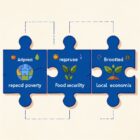What Economic Impact Do Food Stamps Have Locally?

Do you ever wonder how the use of food stamps can affect your local economy?
Imagine a small town where the majority of residents rely on food stamps to put food on the table.
In this introduction, we will explore the economic impact of food stamps at a local level.
By analyzing data and examining real-life examples, we aim to provide an objective and analytical perspective on the effects of food stamps on local economies.
Key Takeaways
- Food stamps stimulate the local economy by increasing spending power and generating economic activity.
- SNAP benefits create job opportunities in various sectors, including agriculture, food processing, and retail.
- Food stamps promote health and nutrition by improving access to a wider variety of nutritious foods.
- Food stamps have long-term economic implications, including reducing poverty rates, potential cost savings in healthcare, and contributing to economic stability and growth.
Cost and Expenditure of Food Stamps
To understand the economic impact of food stamps locally, you need to examine the cost and expenditure of the program. The cost of the food stamp program is a significant factor in understanding its economic impact. In 2020, the program cost the federal government approximately $68 billion. This substantial investment reflects the government’s commitment to providing assistance to low-income individuals and families.
In terms of expenditure, it’s important to note that food stamps are distributed through the Supplemental Nutrition Assistance Program (SNAP). According to data from the United States Department of Agriculture (USDA), the average monthly benefit per person in 2020 was $125. This amount may vary depending on factors such as household size and income.
The expenditure on food stamps directly affects the local economy. When individuals and families receive SNAP benefits, they’ve more purchasing power to buy essential goods, such as groceries. This increased spending stimulates local businesses, including grocery stores, farmers markets, and food retailers. Consequently, the infusion of SNAP benefits into the local economy helps create jobs and supports the overall economic well-being of the community.
Understanding the cost and expenditure of the food stamp program is crucial for comprehending its economic impact on a local level. Now, let’s delve deeper into how food stamps stimulate the local economy.
Stimulating Local Economy
When individuals and families receive SNAP benefits, they can actively contribute to stimulating the local economy through increased spending power. The injection of funds into the hands of low-income households allows them to purchase essential goods and services, which in turn supports local businesses and helps drive economic growth. According to a study conducted by the United States Department of Agriculture (USDA), every dollar spent on SNAP benefits generates $1.50 to $1.80 in economic activity. This multiplier effect occurs as recipients use their benefits to buy groceries, pay for housing, and meet other basic needs, leading to increased sales for local retailers and service providers.
In addition to boosting local businesses, SNAP benefits also help alleviate poverty and reduce income inequality. By providing individuals and families with the means to purchase necessities, the program stimulates demand for goods and services, leading to increased production and job opportunities. This creates a positive ripple effect throughout the community, generating additional income and employment opportunities for local residents.
The impact of SNAP benefits on the local economy is evident in various sectors, including grocery stores, restaurants, and healthcare providers. These businesses experience increased sales and revenue, enabling them to hire more employees and expand their operations. As a result, the infusion of SNAP benefits not only supports individuals and families in need but also contributes to the overall economic well-being of the community.
Transitioning into the subsequent section about ‘job creation and employment effects’, the economic impact of SNAP benefits goes beyond stimulating local businesses.
Job Creation and Employment Effects
You can directly observe the job creation and employment effects of SNAP benefits in the local economy. Here are four key ways in which food stamps contribute to job growth and employment opportunities:
- Increased demand for food: SNAP benefits provide low-income individuals and families with the ability to purchase food, which in turn creates a higher demand for groceries. This increased demand leads to more jobs in the local agriculture, food processing, and retail sectors.
- Support for local businesses: When people use their food stamps at local grocery stores and farmers markets, it helps sustain these businesses and supports local jobs. Small businesses, in particular, benefit from the steady stream of customers that SNAP brings.
- Indirect job creation: As businesses experience increased sales due to SNAP spending, they may need to expand their workforce to keep up with demand. This can lead to the creation of additional jobs in the community.
- Economic multiplier effect: SNAP benefits have a multiplier effect on the local economy. When individuals and families have more money to spend on food, it stimulates economic activity, generates tax revenue, and ultimately supports job creation in various sectors.
Health and Nutrition Benefits
How do food stamps positively impact the health and nutrition of individuals and families in the local community?
Food stamps, also known as the Supplemental Nutrition Assistance Program (SNAP), play a crucial role in promoting health and nutrition among individuals and families in the local community. By providing financial assistance for purchasing food, food stamps help ensure that vulnerable populations have access to nutritious meals. This support has a significant impact on the well-being of those who receive it.
A study conducted by the USDA found that food stamp recipients tend to consume more fruits, vegetables, and whole grains compared to non-recipients. This is a direct result of the increased purchasing power that food stamps provide, allowing individuals and families to afford a wider variety of nutritious foods. Additionally, the study found that food stamp recipients are less likely to experience food insecurity, meaning they have consistent access to enough food for an active, healthy life.
To further illustrate the positive impact of food stamps on health and nutrition, consider the following table:
| Health and Nutrition Benefits of Food Stamps |
|---|
| 1. Increased consumption of fruits and vegetables |
| 2. Access to a wider variety of nutritious foods |
| 3. Reduced food insecurity |
| 4. Improved overall dietary quality |
| 5. Enhanced health outcomes |
These findings highlight the importance of food stamps in improving dietary choices and overall health among individuals and families in the local community. By supporting access to nutritious foods, food stamps contribute to the well-being and long-term health of those who rely on them.
Long-Term Economic Implications
Food stamps have significant long-term economic implications for local communities. Here are four key points to consider:
- Increased local spending: Food stamps inject money directly into local economies, stimulating local businesses. According to a study by the USDA, every $1 in food stamp benefits generates $1.50 to $1.80 in economic activity. This increased spending helps support local jobs and businesses, creating a ripple effect throughout the community.
- Reduced poverty rates: Food stamps play a crucial role in reducing poverty rates in local communities. By providing assistance to low-income individuals and families, food stamps help alleviate financial burdens and improve overall well-being. This reduction in poverty leads to improved economic stability and potential long-term economic growth.
- Health care cost savings: By ensuring access to nutritional food, food stamps contribute to better health outcomes, ultimately leading to potential cost savings in healthcare. Research has shown that adequate nutrition can help prevent chronic diseases, reducing healthcare expenses for individuals and the community as a whole.
- Education and workforce development: Food stamps can enable individuals to invest in education and workforce development, leading to improved employment prospects and higher wages. By providing a safety net during times of financial hardship, food stamps can help individuals gain the skills and qualifications necessary to secure better-paying jobs, ultimately benefiting the local economy.
In conclusion, food stamps have long-term economic implications that include:
- Increased local spending
- Reduced poverty rates
- Potential healthcare cost savings
- Improved education and workforce development.
Frequently Asked Questions
How Do Food Stamps Impact the Overall Poverty Rate in Local Communities?
Food stamps have a significant impact on the overall poverty rate in local communities. They provide essential support to low-income individuals and families, helping them meet their basic needs and alleviating financial strain.
Can Food Stamps Be Used to Purchase Non-Food Items Such as Cleaning Supplies or Personal Care Products?
You can’t buy non-food items like cleaning supplies or personal care products with food stamps. The purpose of food stamps is to help low-income individuals and families afford nutritious food.
Are There Any Restrictions on the Types of Food That Can Be Purchased With Food Stamps?
There are restrictions on the types of food that can be purchased with food stamps. These restrictions aim to ensure that recipients are purchasing nutritious foods and not using the benefits for non-essential items.
What Measures Are in Place to Prevent Fraud and Misuse of Food Stamps?
To prevent fraud and misuse of food stamps, measures like strict eligibility requirements, income verification, and periodic reviews are in place. Retailers are also monitored for compliance and face penalties for fraudulent activities.
How Do Food Stamp Programs Vary Across Different States in Terms of Eligibility Requirements and Benefits Provided?
Food stamp programs vary across states in eligibility requirements and benefits. You can analyze data to objectively compare and evaluate these differences. Understanding these variations is crucial for assessing the economic impact of food stamps locally.



